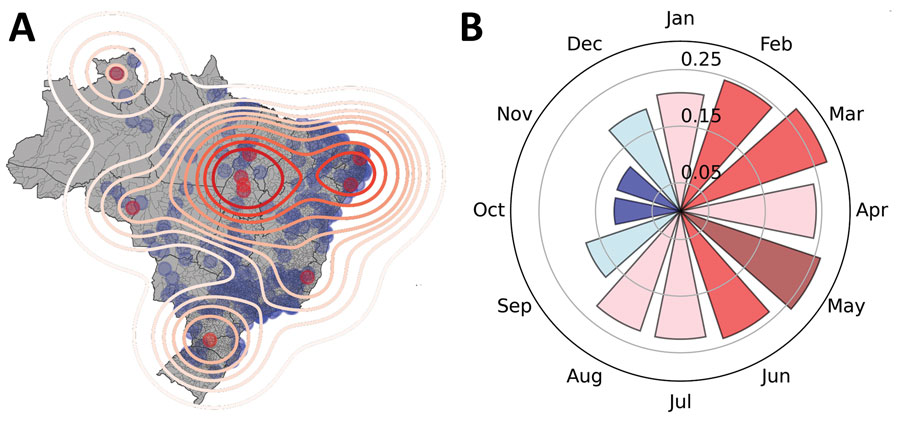Volume 28, Number 4—April 2022
Dispatch
Zika Virus after the Public Health Emergency of International Concern Period, Brazil
Figure 2

Figure 2. Geographic and temporal distribution of reported Zika cases after the Public Health Emergency of International Concern period, Brazil, 2017–2020. A) Consistency-weighted kernel density estimates. Contours generated with bandwidth determined by Scott’s rule adjusted by a factor of 0.7 (12), overlaid on the distribution of all case data. Points show centroids of municipalities that reported infections to the Sistema de Informação de Agravos de Notificação (9) database. B) Monthly Moran I statistic, estimated at the state level. Red indicates p<0.05; blue indicates p>0.05.
References
- Yakob L, Walker T. Zika virus outbreak in the Americas: the need for novel mosquito control methods. Lancet Glob Health. 2016;4:e148–9. DOIPubMedGoogle Scholar
- European Centre for Disease Prevention and Control. Rapid risk assessment: microcephaly in Brazil potentially linked to the Zika virus epidemic. Stockholm: European Centre for Disease Prevention and Control; 2015.
- Hay JA, Nouvellet P, Donnelly CA, Riley S. Potential inconsistencies in Zika surveillance data and our understanding of risk during pregnancy. PLoS Negl Trop Dis. 2018;12:
e0006991 . DOIPubMedGoogle Scholar - Fischer C, Drosten C, Drexler JF. The difficulties in obtaining reliable Zika virus diagnostics. Lancet Infect Dis. 2019;19:240–1. DOIPubMedGoogle Scholar
- Moore SM, Oidtman RJ, Soda KJ, Siraj AS, Reiner RC Jr, Barker CM, et al. Leveraging multiple data types to estimate the size of the Zika epidemic in the Americas. PLoS Negl Trop Dis. 2020;14:
e0008640 . DOIPubMedGoogle Scholar - US Centers for Disease Control and Prevention. Zika in the US. 2021 [cited 2022 Feb 16]. https://www.cdc.gov/zika/geo/index.html
- Pan American Health Organization. PLISA health information platform for the Americas. 2021 [cited 2022 Feb 16]. https://www3.paho.org/data/index.php
- World Health Organization. Prioritizing diseases for research and development in emergency contexts. 2021 [cited 2022 Feb 16]. https://www.who.int/activities/prioritizing-diseases-for-research-and-development-in-emergency-contexts
- Health Surveillance Secretariat of the Ministry of Health. Information about SINAN (Sistema Informação Agravos Notif. e RESP (Registro Eventos Saúde Pública) [in Portuguese]. Brazil; 2016 [cited 2022 Feb 16]. http://portalsinan.saude.gov.br
- Rosenblatt M. Remarks on some nonparametric estimates of a density function. Ann Math Stat. 1956;27:832–7. DOIGoogle Scholar
- Instituto Brasileiro de Geografia e Estatística. Study on the Continuous Population Census Modality. Brazil: The Institute; 2020.
- Moran PAP. Notes on continuous stochastic phenomena. Biometrika. 1950;37:17–23. DOIPubMedGoogle Scholar
- O’Reilly KM, Lowe R, Edmunds WJ, Mayaud P, Kucharski A, Eggo RM, et al. Projecting the end of the Zika virus epidemic in Latin America: a modelling analysis. BMC Med. 2018;16:180. DOIPubMedGoogle Scholar
- World Health Organization. Efficacy trials of ZIKV vaccines: endpoints, trial design, site selection. Meeting report. Geneva: World Health Organization; 2017.
- Scott DW. Multivariate density estimation: theory, practice, and visualization. New York: John Wiley & Sons; 1992.
Page created: February 22, 2022
Page updated: March 19, 2022
Page reviewed: March 19, 2022
The conclusions, findings, and opinions expressed by authors contributing to this journal do not necessarily reflect the official position of the U.S. Department of Health and Human Services, the Public Health Service, the Centers for Disease Control and Prevention, or the authors' affiliated institutions. Use of trade names is for identification only and does not imply endorsement by any of the groups named above.